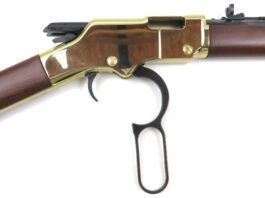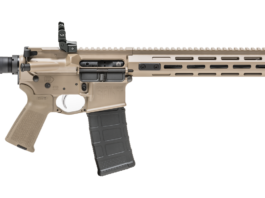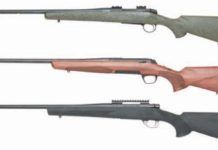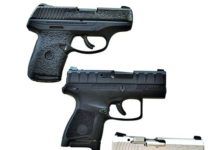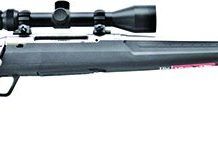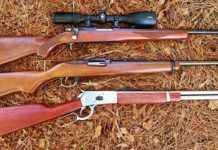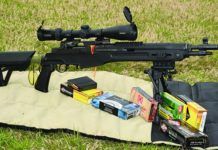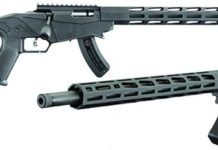22-250 Bolt-Action Rifles from Browning, Howa, and Bergara
Can a good varmint rifle also serve as a low-recoil starter bigger-game rifle? We test a Howa Model 1500 Youth, a Bergara B-14 Hunter short rifle, and a Browning X-Bolt Micro Midas to find out.
Aw Shucks, Thank You…
Reader PM resubscribed after many years to get our 2nd Amendment reporting and commentary. Reader Richard got his latest issue in the mail, and it was "trimmed" on the side. Here's how to resolve that.
VALUE GUIDE: Bolt-Action Rifles (Short Actions)
VALUE GUIDE: Bolt-Action Rifles (Short Actions)
Gun Tests Ammunition Comparisons
Here's a compilation of head-to-head ammunition testing conducted by Gun Tests magazine.
Interpretations of Scouts from Ruger, Savage, Mossberg
While these three rifles did check off some of the boxes for the Scout specs, they all fell short of being a true Scout Rifle, at least going by Cooper's definition. But would we want to carry these rifles for long periods of time, and could we easily hit a target out to 100 yards? Yes, most definitely.
VALUE GUIDE: SHORT-ACTION RIFLES (MULTIPLE CHAMBERINGS)
VALUE GUIDE: SHORT-Action Rifles (MULTIPLE CHAMBERINGS)
GUN NAME
ISSUE
GRADE
COMMENTS
Savage 110 Apex Storm XP 57344 6.5 Creedmoor, $605
June
2019
A-
Best Buy. Accurate, reliable, and fast handling. The Vortex scope is a credible optic.
Mauser M18 M18065P
6.5 PRC, $628
June
2019
A-
Accurate and reliable. The rifle is expensive compared to the others.
Savage Axis II XP Rifle 57289
6.5 Creedmoor, $400
June
2019
B+
A credible choice. We would save a few more weeks to buy the Apex. …
6.5mm Bolt-Action Rifles: Savage and Mauser Compete
Recently, at one of his favorite shops, a Gun Tests rater saw that one of his friends, a 70-year-old shooter still going strong, was looking for a "long-range" rifle. Long-range rifle shooting seems to be quite popular. We don't necessarily mean Camp Perry-type shooting, but ordinary shooters wishing to fire their rifles at distant targets and hit the target more often than not. With a wide range of 6.5 Creedmoor ammunition and the introduction of nine new rifles from a single maker in this caliber, we feel that the 6.5 Creedmoor is likely to remain popular for many years. The cartridge is touted as highly accurate, with low recoil, and enough velocity to consistently kill deer-sized game cleanly with a well-placed shot. The 6.5 Creedmoor also offers long-range efficiency with less component expense for handloads, not to mention lower recoil than the 308 Winchester or 7mm Remington Magnum.
Because of the friend's interest, we elected to test two new rifles in 6.5 Creedmoor and a third in another midrange offering, the 6.5 Precision Rifle Cartridge, introduced by Hornady. The two "Creeds" were both Savages. The first was the Axis II XP Stainless Bolt-Action Rifle with Scope 57289 in 6.5 Creedmoor. The Savage Axis II is the newest development of the Savage Axis line, a package gun. Package guns are simply affordable rifles supplied with scope rings and bases and a rifle scope. The buyer saves considerable amounts of money by purchasing the package versus purchasing each component separately. The rifle will have been mechanically bore-sighted by the manufacturer. In general, these rifles offer good value and save both time and money compared to obtaining and putting together your own package.
The second was a Savage 110 Apex Storm XP 57344 in 6.5 Creedmoor, substantially more expensive than the Axis. The Savage 110 differs considerably from the Savage Axis rifle. The receiver of the Axis is closed and easier to machine, while the Savage 110 is more traditional. A locking lug in the stock attaches to the Axis receiver, while the Savage 110 locking lug is sandwiched between the barrel and the action. The 110 action has more leverage and primary extraction seems better, although the practical difference may be difficult to prove.
Though the 6.5 Creedmoor is increasingly popular, the 6.5 PRC may become a viable cartridge for many users. The 6.5 PRC seems unlikely to be chambered in anything but bolt-action rifles, and we felt this a good opportunity to test a rifle we have not yet put through the grueling Gun Tests procedure, the Mauser M18. This rifle came chambered in 6.5 PRC, allowing us to gauge the difference in accuracy, power, and recoil between this cartridge and the 6.5 Creedmoor. The rifle was fired with the Hornady 6.5 PRC Match load, one of only two available, both manufactured by Hornady. Each box of 20 6.5 PRC rounds cost $31 from SportmansWarehouse.com.
There are also those who flatly state the 6.5 Creedmoor will do nothing the ancient 6.5x55mm round will not do, so we added a rifle chambered in the latter cartridge to give us some historical perspective. There are a few current rifles chambered for this cartridge, but we found an original Mauser rifle, manufactured in 1895, chambered for the 6.5x55mm Swedish, also known as the 6.5x55mm Swedish Mauser, and sometimes called the 6.5x55mm Mauser. The round first appeared in 1891, according to Cartridges of The World's 16th Edition. We are not collectors per se, but we like testing viable hunting rifles to see if the new stuff gives any better performance than the oldies. A collector may turn up his nose at the humble sporterized Mauser, but we found it to be a great light rifle for woods hunting.
VALUE GUIDE: Bolt-Action Rifles (MULTIPLE CHAMBERINGS)
Log on to Gun-Tests.com to read complete reviews of these products in the designated months.
Highly-ranked products from older reviews are often available used at substantial discounts.
Compact 44 Rem. Mag. Rifles: Rossi and Ruger Shoot It Out
The 44 Remington Magnum has been a favorite hunting cartridge for some of our test team members who live in states where straight-wall cartridges are legal for deer hunting, but where short sight line conditions keep ranges way down. Chambered in short, carbine-length rifles, the 44 Rem. Mag. can be quick to shoulder, fast to shoot, and offer plenty of power. As one of our 44 Rem. Mag. hunters said: "They make big holes and leave a nice blood trail." These rifles are lightweight and make for easy carry. In brush-choked terrain when pushing deer, sitting in tree stand for a black bear, or waiting on pigs to wallow, these carbines offer power, and in lever-action models, super-fast follow-up shots. They can also make a good truck gun.
While lever-action 44 Rem. Mag. carbines are common, we wanted to look at something different and assembled three candidates. To serve as a baseline, we chose the Rossi R92, a clone of the iconic Winchester Model 1892 and a good example of a typical lever-action 44 Mag. carbine with exposed hammer, iron sights and tubular magazine that's loaded via a loading port. The Ruger 77/44 is quite different. It is a bolt-action rifle and comes with scope mounts and detachable rotary magazine. The Ruger 96/77 is a lever-action carbine similar to the Savage Model 99. The hammer is enclosed in the receiver, it has a scope mount built into the receiver, and uses a detachable magazine. The 96/77 was produced from 1996 through 2004 and our test sample was lightly used. The R92 and 77/44 are both current production guns and easily obtained; used 96/44 models are also fairly easy to find, especially on online gun-auction websites.
American Tactical’s AR-15 Replacement Trigger
Hi everybody, this is Jamie with American Tactical. We're here at Range Day 2019. We are introducing the new Saf-T First trigger. This is an AR-15 trigger that will charge on safe. Your red trigger is your original trigger. This is what you are operating with now. You can fire it, but you cannot go to safe while it is open.
Springfield Armory’s Socom 16 CQB Keeps Pace at the Range
In 1974, Springfield Armory of Geneseo, Illinois began offering a civilian-legal semi-automatic rifle based on the M14, which it christened the M1A. Since then, Springfield Armory has offered several versions of the rifle, including a number of carbines utilizing a 16.25-inch-long barrel. In the September 2014 issue of Gun Tests, we evaluated the Springfield Armory Socom 16, which added a scout-style scope mount positioned forward of the ejection port. This was a simplification of the Socom II we covered in 2012 that featured a multi-rail forend made by Vltor Weapons Systems. The subject of this evaluation is the newest carbine, the $2442 Socom 16 CQB. The CQB uses the same barreled action as previous carbines but sheds the traditional stock in favor of a carbon-fiber-reinforced polymer stock by Archangel featuring a 5-position adjustable-length buttstock.
April 2019 Short Shots: New Rifles for 2019
For 2019, Sturm, Ruger & Company, Inc. has introduced magnum models of the Ruger Precision Rimfire rifle and a new BX-15 Magnum magazine that accept 17 HMR and 22 WMR cartridges. Like its 22 LR predecessor, these new magnum offerings maintain the same ergonomics, trigger, and manual of arms as the larger centerfire Ruger Precision Rifle. The Ruger Precision Rimfire has a molded, one-piece chassis and adjustable buttstock assembly manufactured of glass-filled nylon.




























